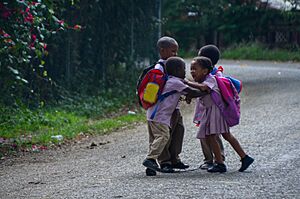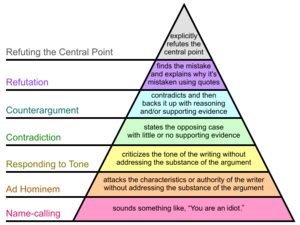Conflict facts for kids
A conflict is like a disagreement or a struggle between people. It can be about different ideas, or sometimes it can even be a physical fight. The word "conflict" comes from a Latin word meaning "to come together for a battle."
Conflicts happen when people have different needs, values, or ideas that they can't agree on. Sometimes, conflicts can lead to fights or even wars, especially when people use weapons. When ideas conflict, people often use propaganda to try and convince others.
Contents
What Are the Main Types of Conflict?
Conflicts can show up in many ways. Here are some common types:
- Content conflict happens when people disagree about how to handle a certain issue. This can actually be good! It can make people talk more and think harder about a problem.
- Relationship conflict is when people disagree about each other personally. This kind of conflict can make people feel annoyed, suspicious, and less motivated. It often comes from not getting along well with someone.
- Process conflict is about disagreeing on how a group should do a task. It's about the methods or steps the group uses.
- Task conflict is when people in a group have different opinions or ideas about a specific task. This can be helpful because it encourages everyone to think deeply about the problem. It often leads to better decisions and makes people feel more satisfied with the group's choices.
- Affective conflict is an emotional conflict. It comes from personal disagreements and can cause distrust and hostility. This type of conflict is usually seen as negative and can make things difficult.
- Cognitive conflict happens when people have different ways of looking at a task or different judgments. It can improve decision-making and help group members share information freely. This is often seen as a positive kind of tension that helps groups work well.
Conflicts can happen within a group (like a school club) or between different groups (like two sports teams). Here are some examples:
- Conflict of interest means someone is involved in different things that might make it hard for them to make fair decisions.
- Cultural conflict happens when different cultural values or beliefs clash.
- Intellectual conflict is a type of cultural conflict, where ideas or ways of thinking clash.
- Ethnic conflict is a disagreement between two or more different ethnic groups.
- Organizational conflict is when people working together have different needs, values, or interests that cause problems.
- Role conflict happens when a person has different responsibilities that are hard to do at the same time.
- Social conflict is a struggle between different social groups or classes, often about who has power or control.
- Work–family conflict is when the demands of someone's job and their family life clash.
How Conflicts Develop
Conflicts don't just happen; they often grow and change. Sometimes, they can even get out of control. Here's how a conflict usually develops:
| Phase | What it's called | What happens |
|---|---|---|
| Phase I | Latent phase | The situation that could cause a conflict starts to appear. |
| Phase II | Conscience | Both sides realize there's a conflict. |
| Phase III | Action | Both sides start to react based on their thoughts and feelings. |
| Phase IV | Interactions | Both sides interact, using different ways to deal with the conflict. |
After these phases, a conflict can sometimes get even bigger or more intense.
How Do People Behave in Conflicts?
People react to conflict in different ways. Some common behaviors include:
- Flight (or Evasion): This means trying to avoid the conflict or run away from it.
- Fight (or Enforcement): This means trying to win the conflict, sometimes by being aggressive or trying to destroy the other side's position.
- Subordination (or Adaptation): This means giving in or accepting what the other side wants.
- Delegation: This means asking someone else (like a teacher or parent) to solve the problem.
- Compromise: This is when both sides agree to give up a little bit of what they want so they can both get some advantages.
- Consensus: This is the best way to solve a conflict. It means working together to find a solution that everyone agrees on and feels good about.
The first few behaviors (flight, fight, subordination) are often about avoiding or confronting the conflict. The last ones (compromise, consensus) are about finding constructive ways to solve it. Consensus is often seen as the best way to resolve conflicts peacefully.
How Can Conflicts Be Solved? (Mediation)
Conflicts can get worse when people in a group take sides. One good way to solve a conflict is through mediation. This is when a person who is not involved in the disagreement helps the people in conflict talk things out.
A mediator is like a neutral guide. They help the people who are disagreeing work through the problem and find a solution together. Mediation works best when the conflict isn't too intense and when everyone involved is still willing to try and find an agreement. It can also help improve interpersonal relationships and communication between people.
Related Pages



